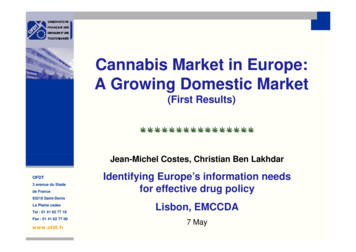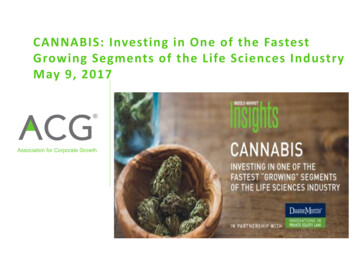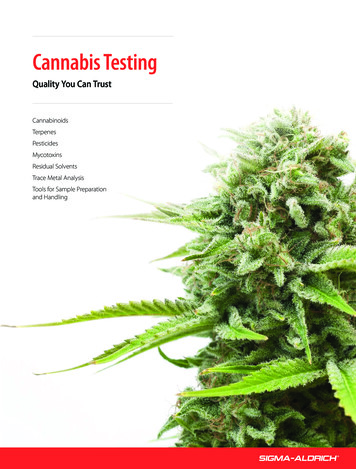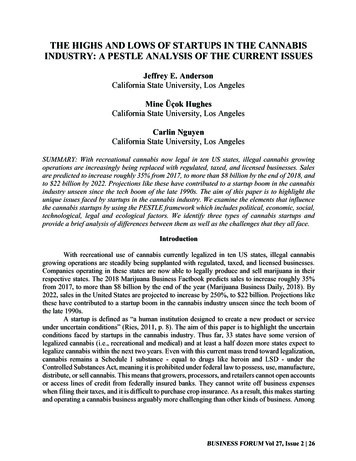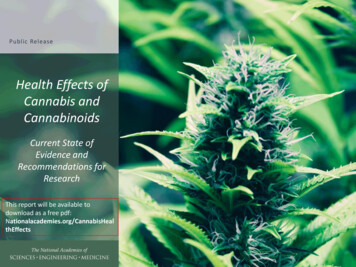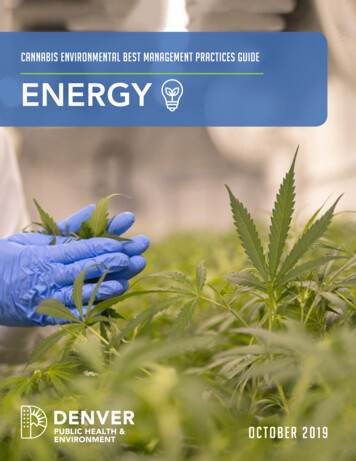
Transcription
Cannabis Environmental Best Management Practices GuideENERGYoctober 2019
ENERGYExecutive SummaryDepending on the environment, growing cannabis can be a very energy-intensive process. Thisenergy consumption is the leading driver of greenhouse gas emissions for the industry and isone of the biggest opportunities for growers to cut costs, critical in a market where decreasingwholesale prices and increasing competition are putting pressure on grows to be more costeffective to stay in business.1The best time to incorporate energy efficiency and renewable energy measures into a cultivationis before it is built, but there are plenty of retrofit actions that growers can take to improve theirenergy usage in established facilities, as well.During the process of designing a cultivation, one of the most immediately impactful actionsone can take to reduce energy costs is to grow in a greenhouse or outdoors. However, thereare important economic and risk tradeoffs with these options — such as having limited outdoorgrowing seasons in Colorado and the more complex architecture of a greenhouse — that must beconsidered when weighing how and where to build your grow.Figure 12: End Use Electricity Consumption for an Indoor Grow5% 3% 1%2%HVAC/DehumidificationLighting38%Space HeatingWater Pumping51%CuringCO2 InjectionAs shown by the above chart, lighting and HVAC are the largest loads in a typical indoor cannabisfacility. For growers looking for low-hanging fruit in existing or new-build indoor facilities,tackling the efficiency of your lighting and HVAC systems is the easiest and most impactful firstopportunity.Best management practices that will be covered in this report include (in order of appearance) Measurement and verification Scheduling Lighting Greenhouses HVAC & Dehumidification On-site and off-site power generationHood, G. (2018) Colorado Public Radio, Nearly 4 Percent of Denver’s Electricity is Now Devoted to Marijuana1Kowley, N. (2017) SWEEP, A Budding Opportunity: Energy Efficiency Best Practices for Cannabis Grow Operations21
ENERGY EFFICIENCY & MANAGEMENTOVERVIEWIndoor cannabis cultivation is a resourceintensive process with energy demands asthe greatest contributor to the industry’senvironmental footprint. While growingcannabis in a controlled indoor space leads tomore consistent year-round production, highenergy costs and increasing price competitionare pushing cultivators to get familiar with theenergy impacts. Decisions relating to cultivationfacility design should be driven by locationspecific metrics and cultivation processes.High energy use and the associated air qualityand emissions contribute to negative publicperception; therefore, active energy efficiencyefforts can help cannabis businesses createpositive improvements within communities.Figure 2: Primary Electricity Use for Indoor Cannabis rGrow umpsC0 22
There are three primary reasons why cultivatorsshould look to reduce energy profiles:Economic Competitiveness:Energy use represents a significantportion of a cultivation facility’s totaloperating budget. As the industrycontinues to mature in Colorado,the market is becoming increasinglyprice competitive. Organizationsthat reduce energy consumption,and thereby energy costs, will bebetter situated to succeed in thisincreasingly competitive market.Community Relations: As thecannabis industry continues to grow,the electric demands of cultivationfacilities could potentially lead togrid outages that affect the localcommunity. For example, Oregon’sPacific Power has attributed sevenminor community outages to growoperations.2ELECTRICITY USE2013-2018Electricity use from cannabiscultivation andinfused productsmanufacturing grew fromabout 1% to about 4% ofDenver’s total electricityconsumption between 2013and 2018.Environmental Impact: Electricityproduction is responsible forapproximately one third of totalgreenhouse gas emissions in theUnited States. Over the past decade,various efforts to mitigate climatechange have resulted in nationalelectric demand remaining flat (zeropercent growth).In contrast, Denver’s electricity consumptionhas continued to increase over the pastseveral years due to a variety of factors,including overall community growth.Electricity use from cannabis cultivation andinfused products manufacturing grew fromabout 1% to about 4% of Denver’s totalelectricity consumption between 2013and 2018.While there is no singular solution forcultivators looking to reduce facilities’energy profiles, the listed best practicesare intended to provide a framework bywhich organizations can begin to develop acomprehensive energy management plan.3
MEASUREMENT & VERIFICATIONProcess DescriptionYou don’t know what you don’t track. It isimportant for growers to understand andknow how their facility uses energy in orderto evaluate opportunities for improvement.Developing an appropriate M&V processwill depend on both facility-specific factors(size, existing infrastructure, geography, etc.)and an organization’s specific economicand sustainability goals. The following bestpractices are intended to provide a startingpoint for facility managers.MetricsThere is currently a paucity of relevant, highquality energy data in the cannabis industry.Cultivators should measure and sharefacilities’ energy usage data to make morestrategic equipment and process decisionsas well as to contribute to an understandingof the current state of the industry. Onebenchmarking tool is Resource InnovationInstitute’s Cannabis PowerScore.Recommended metrics to track include:Table 2: Key Metrics to TrackMetricDescriptionUnitsgrams/WattNotesAverage RangeLighting Yieldper WattUsed to compare lightingtechnologies and strains.Total EnergyEfficiencyIdentifies total production grams/kWhefficiency; helps identifytrends in building.Measure monthly and annuallyUse total kWhs for building.Total dried productweight kWh/cycle Yield per kWhSpaceUtilizationDemonstrates if thecultivation space isbeing maximized forproduction.Use square footage ofcultivation space only.39.5g/sq. ft.LightingIntensityµmol/m2/sMeasures whether thelights are providing thedesired photosyntheticphoton flux density (PPFD);can help identify correcttime to replace lights.Measure at canopy.Measure for each type oflighting, for each stage ofgrowth.Refer to Table 3:Lighting Technologiesfor CannabisProductionDaily LightIntegralMeasures the dailyaccumulation ofphotosynthetically activeradiation (PAR) spectrumlight reaching the plants.mol/m2/dayFormula: μmol/m2/s (or PPFD) Denver Outdoor Avg.x 3600s x photoperiod (hr/day) Winter 15-30 mol// 1,000,000m2/daySummer 25-45mol/m2/dayLoad FactorUsed to manage peakpower demand; higherLoad Factor reduces costof energy.kWh / (peakUse monthly electricity figures. 0.60 poorkW * days * 24 Days equals days in billing0.60 - 0.75 fairhours per day) period. 0.75 goodgrams/sqftMeasure grams of flower andOverall average 1.0trim in dry weight. Use lighting g/Wwattages, including ballasts.Measure over one grow cycleand annually.4
Guidance on Collecting DataThree levels of data, in order from leastgranular to most, to consider are:Level 1 — Properly interpreting and recordingmonthly utility bills.Level 2 — Requesting utility interval data, ifavailable.Level 3 — Installing data loggers at thebuilding or sub-meter level.Utility bills contain great information butare often poorly interpreted and recorded.A facility manager should break out totalenergy used (kWh), peak demand (kW),consumption-based charges, demandbased charges, and fees and taxes for eachbill. Inputting this info (along with waterand production data) into a standardizedspreadsheet should take only a few minuteseach month.OBTAINING BUILDING DATA FROMXCEL ENERGYEnergy usage data can pertain to electricity,natural gas, steam, fuel oil, diesel, on-sitesolar or any other energy source. The datamust cover consumption from January1 through December 31 of the previousyear. Consumption data can be collectedthrough an Xcel Energy account, a naturalgas supplier account or from past bills. XcelEnergy’s My Account portal is a helpfulonline tool for obtaining monthly use figuresand annual totals.Xcel Energy has developed a data accessportal that allows tenants and building ownersto automatically receive aggregate energyconsumption data imported directly intoENERGYSTAR Portfolio Manager accounts.ENERGYSTAR Portfolio Manager accountsmust be set up prior to beginning theapplication. Visit www.xcelenergy.com andnavigate to the Programs and Rebates page;click on the Business icon; then select the NewConstruction and Whole Building category tolearn more about energy benchmarking.Utility Interval Data Facilities with smart meters can request15-minute interval data from the energyprovider. Facilities can also opt to pay for Xcel’sInfoWise service, which uses interval data tocreate a web-based energy dashboard thatprovides various insights and metrics. Thisservice costs 150 per month, with a 900equipment charge if a smart meter is notalready in place. Cultivators can also install equipmentto log energy data. This can be doneconcurrently with a Building ManagementSystem (BMS)/Energy Management System(EMS) installation, or can be done solely forlogging energy data. Installation will allowfor capturing higher frequency, submetereddata that can provide a great deal of insightinto how a facility is using energy.When properly configured and monitored,a robust BMS/EMS can quickly alert a facilitymanager about broken or malfunctioningequipment, saving facilities from energywaste, equipment failure, power loss and evenloss of crop in the event of malfunctioningenvironmental controls. See below for moreinformation on BMS/EMS systems.Building Management Systems/EnergyManagement SystemsFacility managers looking for a comprehensivedata solution should consider installing a BMSor an EMS. As there are many different types ofBMS/EMS systems available on the market, theU.S. Department of Energy has developed asuite of Specification and Procurement SupportMaterials to help managers identify the right fitfor each facility.Energy Audit/Engineering Assistance StudyPerforming a comprehensive energy audit orengineering assistance study (EAS) is often thequickest way to acquire the insights neededto develop an effective energy managementstrategy, but enacting this process typicallyrequires partnering with a qualified third-partyprovider. Xcel’s Energy Analysis Program is agood starting point for facility managers that are5
interested in pursuing these options and alsooffers several financial incentive programs toreduce an organization’s out-of-pocket costs.It would benefit the operator to install submetersinside the building to collect power-usage data,such as those manufactured by e-mon or PowerTakeOff. Submeters measure the power usedin a specific area and/or by certain pieces ofequipment, giving a more detailed picture of howand where energy is consumed in the building.PORTFOLIO MANAGERBecause of Denver’s Benchmarking Ordinance,Denver commercial and multifamily buildingsthat exceed 25,000 square feet are required toanalyze and report their energy performanceusing Energy Star’s free Portfolio Manager tool.For how to set up an account, cannabis businessowners and/or facility managers can refer to theCity of Boulder: How-to Guide for Medicaland Recreational Marijuana Business LicenseEnergy Reporting and Carbon Offset.Engage SpecialistsAn energy specialist (such as a Certified EnergyManager) can perform any of the above tasksfor a cultivator, particularly if a grower shouldseek out an experienced contractor to installsubmeters. Interested cultivators should considera local trade group or association such as RockyMountain Association of Energy Engineers.Additionally, a specialist can perform an on-siteenergy audit or engineering assistance study(EAS) to reveal and evaluate energy savingsopportunities. As mentioned below, Xcel Energyoffers related grants/incentives.As the cultivation industry matures, theavailability of energy, water, lighting and spaceefficiency metrics as related to production databecomes imperative. Individual cultivators —as well as the industry at large — should haveintimate knowledge of these measures and ofhow particular technologies and behaviors affectresource and production efficiency.Resources: Xcel Energy - Business Programs & Rebates Sample Energy Audit Form6
SchedulingCultivation facilities in the Denver metro areareceive electric service from Xcel Energyand are billed according to total electricityconsumption (kWhs) and peak demand (kW).How a facility is operated can have significantimpacts on peak demand and the actualcost of energy. Managing the operation ofvarious systems within the facility by settingstaggered room schedules can significantlyreduce energy costs and negative impactson the power grid. Reducing peak demandalso creates community-level environmentalbenefits, because energy providers utilize “peakerplants” that are generally older, less efficient andhave higher emissions to provide additionalelectricity during times of high demand.PROCESS DESCRIPTIONLoad-factor OptimizationEnergy-efficient technologies can improve boththe total energy use and peak demand of afacility. Operating schedules, on the other hand,play a critical role in minimizing peak demandover the month. Grow rooms, particularly inthe flower stage, represent the largest sourcesof peak energy needs when factoring inlighting, cooling and ventilation. All grow roomschedules should be staggered over the 24hour period so the minimum number of roomsrun concurrently. Any overlap of schedules,even for one hour or less, leads to higher spikesin peak electricity demand and higher costs.SUSTAINABILITYASPECTS AND IMPACTSEnergy consumptionGHG emissionsOperational and compliancebudgetsSimilarly, other energy-intensive processes, suchas extraction, cleaning or electric heating, can bestaggered and scheduled carefully with lightingcycles to minimize peak power demands.Should I Veg Under a 24hr or 18:6 Photoperiod?Growers often ask this question when designing their operation, but what is the right answer? Thetruth is, both work! By keeping the lights on for 24 hours a day, plants are exposed to 33% morelight than an 18:6 schedule. This means more light for photosynthesis. However, regular periodsof darkness (lights off) are important for other plant functions. Plants actually use nighttime to takein oxygen (just like people) and burn the glucose that they stored up during the day to grow in aprocess called cellular respiration. Ultimately, the tradeoff between maximizing light during 24hrversus giving plants a break to use their stored energy in an 18:6 schedule more or less cancels out.The most sustainable strategy from an energy point of view is to employ an 18:6 schedule. This willyield happy and productive plants while keeping your energy bill lower at the same time.7
Time of UseMany utilities are moving toward billingcustomers with varying rates based on the time ofday they use electricity. Xcel Energy does not yetcharge time-of-use billing for Secondary Generalrate customers (the rate category most cultivationfacilities fall under). Kilowatt hours cost the sameday or night, but energy can be saved by runningextra equipment during cooler evening periods.If it is necessary to operate extra grow roomssimultaneously, cultivators should try to schedulethose periods overnight when outdoor airtemperatures are lower. This can reduce the coolingload during these times of extra production, therebyreducing energy use and saving money.LightingLighting can be the most energy-intensivecomponent of the cultivation environment. Thedesign of a facility’s lighting system and thetypes of lamps utilized in the grow process willaffect both crop yield and quality. Furthermore,the lighting selection will have a substantialimpact on the size of the HVAC system, and istherefore a significant driver of overall energyuse in the facility. Employee health and safetyshould be considered in the design and deliveryof indoor lighting, as well.SUSTAINABILITYASPECTS AND IMPACTSEnergy consumptionGHG emissionsSolid waste generationEmployee well-beingClimateOperational and compliancebudgetsPROCESS DESCRIPTIONDue to the operational impact of lightingchoices, a host of production-related factorsmust also be considered as cultivators selectthe appropriate lighting technology.Lighting technologies should be measured interms of photosynthetically active radiation (PAR),or the measure of the specific light spectrumcharacteristics. PAR accounts for the spectrum oflight between 400 nanometers (nm) and 700nm,most of the light spectrum used for photosynthesis.Infrared (IR) and ultraviolet (UV) light spectrums falloutside of PAR readings and thus do not registerwith standard light spectrum measuring equipment.IR and UV light are actually classified in a rangeof light referred to as biologically active radiation(BAR). The concept of BAR is still new, and so for thepurposes of this guide, the focus will be on PAR. Theintensity of the lighting system or photosyntheticphoton flux density (PPFD) is measured inmicromoles per second per meter square (µmol/s-m2) and should be carefully monitored for optimalplant growth. This can be measured using a lightmeter with a quantum sensor.8
Lumens are for HumansIf you’re familiar with lighting measurements,you have probably noticed that this documentdoes not discuss some of the attributes usuallyimportant for interior lighting. The factors thatdetermine light quality for plant growth aredifferent from those to consider for workingand living spaces. Measurements that arelargely irrelevant for cannabis lighting includelumens, footcandles and lux.Equipment OverviewHistorically, the top three lighting technologiesused have been T5 fluorescent, metal halide(MH) and HPS. There are now several differentoptions to choose from, including (but notlimited to): LED, light emitting plasma (LEP),CMH, and various combinations of these.LED adoption by cultivators appears to begrowing. If you are considering an LED-lit growenvironment, a peer-reviewed resource thatmay be helpful is Cultivating Cannabis with LEDLighting - A Primer: What You Need to Know.Many of these lighting types have specificspectrums of PAR and are generally used forone stage of growth or another. Prescribingspecific heights above canopy for lightingsystems is not recommended, as PPFD, ageof fixture, bench height and plant height willall dictate the location of the fixture. Fixturedesign and optics will also dictate wherethe light lands, and at what photon densityat various heights, so height and location offixture should be decided on with the help ofthe manufacturer to optimize photon densityand limit waste. There should be a perpetualreview of micromole levels for cannabis andthe need to adjust fixtures with the aid of agood light meter to obtain the necessary PPFD.Lighting fixtures emit energy in the form oflight, as measured in PAR or photosyntheticphoton flux (PPF), and reflectors direct thelight toward the canopy with varying levels ofsophistication and success. LEDs tend to bedirectional in nature and thus generally do notrequire reflectors. Knowing the lighting outputof a fixture alone without understanding,properly configuring and measuring thelighting intensity at the canopy will result insuboptimal lighting conditions. Below aregeneral uses and specifications for each ofthese technologies.3,4Table 3: Lighting Technologies for Cannabis ProductionLightTechnologyGeneral Use/GrowthStageT5/T8 Fluorescent Plant propagation —mothers, clones andearly vegSpectrumBroad spectrum withability to select differentcolor “temperatures”Rated Life inHoursIntensity* inPPFDEfficacy inµmoles/J20,000150 - 5000.84 (T8)Metal HalideAll stages of growth (most Broad spectrum with bluecommonly vegetative)and green peaks6,000 15,000500 - 800TBDCeramic MetalHalideAll stages of growthBroad spectrum20,0008001.46High PressureSodium (singleended)All stages of growth(most commonly flower)Broad spectrum withyellow and red peaks5,000 20,000700 - 9000.94-1.34High PressureSodium (doubleended)All stages of growth(most commonly flower)Broad spectrum withyellow and red peaks5,000 20,000700 - 2,0001.70-2.2Light EmittingDiodeAll stages of growthBroad spectrum or Singlewavelengths with abilityto fine tune colors, UV/Far-red options50,000up to 1,5001.70 - 2.7Light EmittingPlasmaAll stages of growthBroad spectrum plus UV30,000700 - 9001.00*Intensity is measured at manufacturer’s recommended mounting height.**Times listed are the time it takes to reach 70-90% of original output, depending on the number listed by themanufacturer. Lights will sometimes need to be replaced before this time to maintain optimal performance.9
BEST PRACTICESSystem DesignWhen designing for indoor cultivation, it isimportant to identify and understand targetlight levels for optimal growth. The correctmeasurement for obtaining best results is PPFDmeasured at the top of the canopy. Once anoperator has determined the target PPFD, thecultivator should work with an engineer orvendor to design the system around the target.If a manufacturer cannot assist in the design andtechnical review, the cultivator should considerseeking a more capable vendor, or be sure tohave an appropriate consultant on the team.An important consideration when designinga lighting system is PPFD uniformity. Ensuringcrops receive uniform light intensity willhelp ensure that the crop grows uniformly.Deficiencies in light intensity often occur at theedges of cultivation spaces, such as aisles andwalls. These areas often produce decreasedyields due to a lack of light. Lighting vendorsshould provide light plans that at the very leastshow minimum, maximum and average PPFDof the designed area. PPFD uniformity can beimproved by choosing the proper reflectortype when using HID lighting, or in general byincreasing the density of light fixtures. Furtherefficiency can be gained by using reflectivecoatings and paints on walls, floors andequipment to direct photons back toward thecrop. In greenhouses, sensors can be used tomonitor light during the day and turn lights onand off based on the amount of sunlight andthe target PPFD. This is a great way to get themost out of a crop while trying to minimizeelectricity use.3Neil Yorio. (2014) Towards Sustainable Lighting For CommercialCannabis Production. Biological Innovation and Optimization Systems(BIOS)4Jacob A. Nelson and Bruce Bugbee. (2014) Economic Analysis ofGreenhouse Lighting: Lighting Emitting Diodes vs. High IntensityDischarge Fixtures. PLOS One.10
Maximizing Production & EfficiencyRacksMany cultivators are moving to tieredproduction on vertical racks or shelving. Thisstrategy is most common in vegetation roomswhere plants are smaller and require lowerlight intensity. Fluorescent lights or LEDs aretypically used in these stacking situationsbecause they radiate less heat and can beplaced closer to plants. A common questionis, “How far away from the canopy shouldlights hang?”While each light is different, the mostimportant factors to consider when hanginglights are the temperature of the canopy andhow many micromoles are hitting it. Ensuringthe plants are consistently receiving theappropriate micromole level of lighting andthe appropriate temperature level is essentialfor efficient growth.PruningPruning is important to maximizeproduction. Some plants may need to betopped in the vegetative stage to keepthem short and bushy. Light can onlypenetrate a portion of a dense canopy.Taller plants take more time to grow andultimately produce less yield per kWh.For these reasons, it is important to pruneplants multiple times throughout the growthcycle. Typical pruning activities consist ofpruning off all underdeveloped branches onthe bottom third of the plant and removinglarge leaves that are either blocking lightor not receiving light. While sometimescounterintuitive, by removing plant material,pruning allows the plant to redirectresources from underdeveloped areas toparts of the plant that will ultimately increasethe overall yield.GREENHOUSESGreenhouses will continue to take overa large portion of the cannabis industryas regulations become more favorable.Any expansion plans should at leasttake into consideration greenhouseproduction, as it can be a much moresustainable approach although resultswill vary significantly based on locationand design choices. With greenhouseproduction, lights will be needed onlyoccasionally for supplemental light.Weather stations wired to a quantummeter should be used to ensure lightsare only activating when the meter dipsbelow the minimum micromole target.These weather stations allow for themost efficient use of electricity.When designing greenhouse cultivationfacilities, many of the system designswith regard to lighting will be differentwhen compared to indoor cultivation.Greenhouse lighting is still basedon desired PPFD, but must take intoconsideration how much natural light/sunlight will be obtained. Light fixturecount will undoubtedly decrease in mostgeographies compared with indooroperations, as the lights will be usedonly to supplement during periods oflow sunlight levels.Another aspect of greenhouse lightingsystem design is controllability. Manylight fixtures and associated ballasts ordrivers have the ability to be dimmed.There are times in both stages ofgrowth that the plants may desire alight level lower than the full output.Therefore, cultivators can reduceenergy consumption with a dimmingcontrol system. A control system canalso stagger the power up and powerdown of any room and can help preventunnecessary power spikes and potentialdamage to electrical equipment.SEE ALSO: Appendix B: Greenhouses11
TrellisingTrellis nets should be used in most growsystems to support plants as they flower, as wellas when they spread branches to increase lightpenetration. Cultivators should install trellisnetting in the first week of the flower stagebefore plants stretch. Installing low trellisingearly will help keep the plants stable andsupport heavier bud development. Branchesshould be spread and placed evenly throughthe holes in the trellis netting to maximizebenefit. Often multiple trellises will need to beapplied to the same crop over the course offlowering, depending on the size of the plants.Adjustable Light FixturesIt can be beneficial to have adjustable ratchetson the light depending on the technology,layout and manufacturer's recommendations.Having the ability to move the light closer toshorter plants can greatly increase the level ofmicromoles the plant receives. It can also behelpful to pull the lights up and away from tallerplants to prevent burn. Cultivators should be sureto use non-combustible cables or chains whenusing adjustable lighting fixtures.Lighting Maintenance & ReplacementProper maintenance of lighting and lightingcomponents is important for performanceand efficiency. A dirty optic lens or reflectorcould reduce performance by more than 10%.Different lighting technologies have differentmaintenance considerations.High-Intensity Discharge LightingAluminum Reflectors: Calcium, dust and sulfurwill damage reflectors and decrease efficiency.Cultivators should follow the manufacturer’srecommendations for cleaning reflectors, as anywiping of the reflector can damage the finish.Thisshould be done once every six months, or moreoften if heavy accumulation of dust is noticed.Tracking micromole levels at the canopy level willinsure the proper amount of photons is hittingplants. Replacing bulbs and reflectors when theyare underperforming is a sustainable approach.Bulbs: Cultivators should make sure lights areunplugged and have had at least 20 minutes tocool before cleaning or replacing. Using glasswipes to wipe down the bulb and lens is advised,if applicable. Cultivators should wipe down lightsonce every two months or between harvests,but should not wipe the base of the lamp or thesocket. Most manufacturers recommend replacingbulbs every 12 months, along with the reflector.However, bulbs used on a 12 hours on/12 hoursoff (“12/12”) schedule will typically have morerated life hours remaining after one year. Trackingmicromole levels at the canopy level will ensurethe proper amount of photons is hitting the plants.Tracking light levels and only replacing bulbs orlenses when they are underperforming is a moresustainable approach.Ballasts: While magnetic ballasts should bereplaced every two to three years because ofdecreased efficiency, electronic ballasts canoften perform eight to 10 years. Buying a lightonce consisted of purchasing a bulb, ballastand reflector separately. However, most newtechnology includes an electronic ballast withthe reflector, so no choice needs to be made. Magnetic: Magnetic ballasts precededelectronic ballasts, and are heavier, lessefficient, and noisier than electronicballasts. However, they may come with alonger warranty than electronic ballasts,and are less expensive and easier to repair. Electronic: Electronic ballasts have sensitivecircuitry that is more difficult to repair thanmagnetic ballasts. Many electronic ballastshave dimmable options that can help putless light on the plants during sensitivestages of growth. The dimmable optioncan also be helpful in controlling the roomtemperature in extreme weather conditions.As mentioned above, the electronic ballastis more efficient, creates less heat and noise,and typically lasts longer than a magneticballast. RFI (radio frequency interference)has been a problem with older electronicballasts, but manufacturers have beenworking hard to correct that deficiency.Cords/Connection: Cultivators should thoroughlycheck electrical cords for any damage, cuts orabrasions that could affect performance. Also,cords should be insp
XCEL ENERGY Energy usage data can pertain to electricity, natural gas, steam, fuel oil, diesel, on-site solar or any other energy source. The data must cover consumption from January 1 through December 31 of the previous year. Consumption data can be collected through an Xcel Energy account, a natural gas supplier account or from past bills. Xcel

